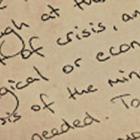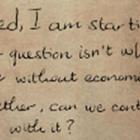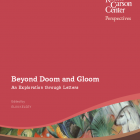Reader Response: Richard Christian
Richard Christian is a philosopher who is currently working on problems of social justice due to climate change at the University of Manchester, United Kingdom.
Richard Christian. June 2015.
r.p.christian@runbox.com
Against doom and gloom
To my peers: a response to some letters that counsel hope
Our sense of doom; we foresee disaster.
Outside, the wind is blowing. The trees have at last revealed their leaves; their greenness is luminescent. Spring is here. But in our thoughts of nature, a mood of foreboding prevails: gazing out over the future of life on Earth, we see disaster, a dark tide, in constant approach. An end-time is coming.
For behold, the day cometh, that shall burn as an oven, And all the proud, yea, and all that do wickedly, shall be stubble; And the day that cometh shall burn them up, saith the LORD of hosts, that it shall leave them neither root nor branch.’
—Malachi 4:1.
Our synthetic world; science must tell us how the earth fares.
We are small and shuffling animals; we each perceive only a short span of time and a small region of space. We sniff the air, and push the soil with our feet. The consequences of our collective action are still mostly hidden from us. We move in an increasingly synthetic world, its scenery bounded by cities, and our experience mediated by screens.
The internet is a timeless, deathless realm. It is the completion of our project; it is a purely human world. It is a world composed only of our own ciphers; we see in it only ourselves, reflected infinitely. It is cleansed of the non-human. Here there is no element to oppose us, no wind nor storm to restrain us, neither root nor grain of soil, nor motion of animal. There is no decay. All time is compressed into an eternal present. And when you lift your eyes to look beyond it, you see only the embodiments of our deeds, and our detritus.
If you notice the loss of a species or the decline of its population, you are unusual. We rely on science therefore to tell us how the earth fares. Our knowledge must come from the testimony of scientists. It is they who drill the cores of ice, measure the recession of glaciers, count butterflies and bats, and track the dispersion of trees.
Bad news from the scientists.
The news from the scientists is bad. They have registered our impact on the earth by declaring that we have ended the Holocene, the stable and temperate geological epoch which began 11,700 years ago with the end of last ice age and which enabled the birth of agriculture and the growth of civilization. We have entered instead the Anthropocene: it is the epoch of the domination of humankind which began with the industrial revolution at the end of the eighteenth century. Future geologists will know that a great dying and transformation occurred in our time: the traces of our action will still be visible in the strata of the earth 100 million years from now.
There are two great ecological problems: climate change and the loss of biodiversity. Carbon dioxide, exhaled as a by-product of our burning fossil fuels to power machines, is increasing in concentration in the atmosphere; by radiative forcing it traps the heat of the sun, and so warms the earth. Its concentration, which before the industrial revolution was 270 ppm (parts per million), is now over 400 ppm, and is predicted by the IPCC to reach up to 500 ppm by the end of the century. It was last that high in the Eocene epoch, around 50 million years ago, when “palms grew in the Antarctic, and crocodiles paddled in the shallow seas around England” (Kolbert, Elizabeth. The Sixth Extinction: An Unnatural History, 171. New York: Henry Holt and Company, 2014). There will be a delay in the warming, so that the earth will not warm to those temperatures in the near future, but the IPCC predicts that the temperature of the earth will increase by around between two to six degrees Celsius by the end of the century. The certain consequence of this will be the suffering and deaths of many millions of people. About a third of the CO2 we release is absorbed by the world’s seas, where, dissolved in water, it forms carbonic acid. Our emissions have made the seas more acid. They have lowered the pH of the seas from 8.2 to 8.1, which is already hindering the calcification of many sea creatures, the process by which they, the barnacles and starfish, the mollusks and coral, build the shells and exoskeletons which are their homes and scaffolding. The calcifiers are very important in the ecology of the seas: their loss will do great damage to marine life. As the atmospheric store of CO2 increases, the acidity of the oceans will increase, and their pH is predicted to drop by end of the century to 7.8. This would be very bad indeed. A similar drop in alkalinity contributed to the massive biotic collapse of the end-Permian extinction 252 million years ago, in which 96% of marine species and 70% of land species went extinct. (The acidification then was caused by CO2 released by a very large volcanic eruption, which also caused global warming, but which in its yearly addition to the atmospheric store was more restrained than human industry.) Biodiversity is in steep decline, and the rate of extinction of species may be several hundred per day; certainly, it is many thousands of times higher than the natural background rate. Ocean acidification is of course only one cause: much diversity is being lost by the destruction of natural habitat for agriculture and mining; many species are going extinct because they cannot adapt to a warmer world or to the predation and competition of invasive species; and many species are still being hunted to extinction, most notably the rhinos, the big cats, and the large fish and mammals of the seas.
More bad news; the disputes of nations.
That is the report of the scientists. It does indeed look bad. There has of course been much discussion about what we the international community should do. To curb the suffering and destruction, it is certain that we must greatly reduce our emission of CO2. But the wealth of our society depends now on the massive combustion of fossil fuels to power the machinery of production of goods; unless we substitute new sources of energy or more efficient machines, we shall hinder the production of wealth, and few people unfortunately seem willing to accept this. (I think it is not so straightforward as is often supposed to create now a world with fewer commodities but more contented people: historically a yearly loss of more than 1% of consumption of energy is associated only with recession and upheaval. The collapse of the Soviet Union registered a yearly loss of just 5%. We are like a man running downhill, who must keep running faster to avoid falling down.) Emissions however must be constrained, internationally and by law. There is otherwise no way to ensure that a reduction in one place (for instance by the increase in efficiency of burning, or the reversion of some people to simple lives) is not wiped out by an increase in another (for instance by an increase in the production of goods). But again unfortunately efforts to unify the international community have so far failed, and it is not clear what could be done differently. Certainly, some nations have no desire to set limits on their emissions and have with more or less subtlety obstructed all attempts to do so.
Moral philosopher Prof. John Broome wrote last year for the London Review of Books about his experience as a lead author on Working Group III of the IPCC. With restraint and faint irony he describes the farcical compilation of the Summary for Policy Makers. It is an enlightening document, and I urge you to read it.
A possible consolation; the hope of redemptive change.
Things look bad. Our tendency is towards gloom. Should it be so? I want to think about reasons for consolation. Or at, least, I will think about reasons to dispel your sense of doom and gloom.
Firstly, things are not so bad as they are sometimes said to be. The popular environmental writer Derek Jensen often says that the earth is dying, and that the collapse of civilization is imminent. This is not true. It is an exaggeration intended to give support to his counsel that we destroy all industry now and become hunter-gatherers again. The earth however is not dying: it will certainly survive this, the latest of several biotic crises in its history. It is hard to know whether civilization will collapse in the foreseeable future. The IPCC at least lists this outcome as improbable and indeed predicts that, despite climate change, world economic growth will continue.
One response to the crisis is to say that we can change, indeed dramatically, that the past should be no guide to the future, and that in their experiments with new forms of life, some people have prefigured this change. We can make a new world in which we live much simpler lives; our motion and desire for goods will be constrained. By our restraint we shall permit a resurgence of the earth and return to a life of harmony with it. This thought is standardly combined with other parts of humanism: our lives will be simpler, but they will be happier. We shall travel less, or hardly at all, but we shall have a sense of belonging, and of authenticity in our culture. We shall work again with our hands; but this will feel rewarding. In throwing off the false ideas that have corrupted us and caused us to dominate nature, we shall throw off other forms of domination too: capitalist will no longer dominate worker, men will no longer dominate women, one race will no longer dominate another. In its most refined form, we are able now to move towards a world free of all domination, and the crisis of the earth has in a sense opened this opportunity for us. In its most extreme form perhaps it is rendered in the manifesto of Deep Green Resistance, which envisages a wave of left-wing militias, disciplined in the principles of human rights, passing over the industrial world, demolishing its dams, power stations and factories, and liberating humankind back into pre-agricultural society.
Redemption denied; the consolation of anti-humanism.
These are green ideas, but they are also humanist. They show, I think, the difficulty we have when we speak of the earth of not speaking of ourselves. Peering into its crisis we divine the resolution of our own frustrations. These visions stand in a long tradition of religious eschatology, of the description of an end-time, when human life will move into a new and final phase which will differ from all that has come before it.
And God shall wipe away all tears from their eyes; and there shall be no more death, neither sorrow, nor crying, neither shall there be any more pain: for the former things are passed away.
—Revelation 21:4.
They inherit the humanist idea of self-transformation, itself an inheritance of Christianity: that we might rise in unity and defeat those who oppose us and throw dust in our eyes. It is the myth of Babel in reverse: that our discord is the consequence of some influence external to us; shaking it off we will take command of our destiny, be united in our vision of the good, and act in concordance.
To my mind, these ideas do much harm: it is the assumption of humanism that is the source of much of our gloom. Humanism has elevated the human animal into something that it cannot be. When we consider this crisis we see then the defeat of the myths we tell of ourselves. By attempting to take a naturalistic view of our species we might see our problems in a better light. If we accept that a species cannot control its own destiny, and that we shall never make a perfect world, we might then take a more accurate view of what is possible. We shall feel less gloomy. How much in the end can we really control? We live in a world more of our making than our choosing.
Our earliest ancestor, Homo erectus, the first bipedal ape, arose in Africa around 2 million years ago. Its success was due its strong throwing arm, its omnivorous diet, its intelligence in making weapons and other tools, and its ability to cooperate. Radiating from Africa around 120,000 years ago, one of its descendent species, Homo sapiens, came to dominate all continents. Wherever it went it hunted to extinction most large animal species. A collapse of megafauna is the best indicator in the geological record of the arrival of humans. In the Americas 70-80% of large vertebrates disappeared as humans migrated south after crossing the Bering Strait. Before the first humans arrived 50,000 years ago, Australia was a tropical rainforest, populated by megafauna most abundant and strange. There were diprotodons, rhinoceros wombats, and the 3-meter-tall short-faced kangaroo. By hunting all the large herbivores to extinction, humans caused the amassing of a great excess of vegetation, which provided fuel for the massive fires that destroyed the rainforests. What remained was the relatively barren landscape populated by dry-adapted plants now familiar to us. The megafauna associated with Africa—lion, rhino, elephant—once populated most of the Earth’s dry land. Examples have survived in Africa only because their ancestors co-evolved with and so learned to evade humans. There was no golden age: ecological damage has always accompanied the spread of our species. (Interestingly, this is not true of Homo neanderthalensis, a related biped and co-descendent of Homo erectus, which lived in Europe for 100,000 years in balance with other vertebrates, but which after some interbreeding with Homo sapiens was made extinct, presumably by its competition. There is something unique to humans in their vigor of killing and radiation.) By their removal of prey and competitor, and their lack of restraining predator, humans are in their reach beyond Africa characteristic of an invasive species.
You are restless and dissatisfied. Every desire satisfied creates a new dissatisfaction. Every striven-for good turns to vapor in your hands. But it is the madness of humanity that you share in: it is the madness that drove men and women constantly onward, across the barren desert and over the polar ice and out to certain death, their rude ships smashed endlessly by violent seas against rocks, in search of new land.
If only men, even as they clearly feel a weight in their mind, which wears them out with its heaviness, could learn too from what causes that comes to be, and whence so great a mass, as it were, of ill lies upon their breast, they would not pass their lives, as now for the most part we see them; knowing not each one of them what he wants, and longing ever for change of place, as though he could thus lay aside the burden. The man who is tired of staying at home, often goes out abroad from his great mansion, and of a sudden returns again, for indeed abroad he feels no better. He races to his country home, furiously driving his ponies, as though he were hurrying to bring help to a burning house; he yawns at once, when he has set foot on the threshold of the villa, or sinks into a heavy sleep and seeks forgetfulness, or even in hot haste makes for town, eager to be back. In this way each man struggles to escape himself: yet, despite his will he clings to the self, which, we may be sure, in fact he cannot shun, and hates himself, because in his sickness he knows not the cause of his malady; […]
—Titus Lucretius Carus, On the Nature of Things, trans. Cyril Bailey (Oxford: Clarendon Press, 1921), 141-42.
Humanity is a mass of contention, and its essence is dispute. Seven billion people are locked in diverse and ancient conflicts; men meet in battle and destroy themselves for religious dreams. This is our history; why think that it will change? Lost at sea, in the darkness of night, storms blast us, and waves throw us. On this ship of fools, what meaning has any hope that she will steer right onward? Five men grapple for the rudder, and ten who ought to make fast the sail are busy inspecting the stitching. Midshipmen, asleep in the hold, are lost in dreams of unity, or theorise future principles of navigation. The captain is a god that never was. Why think that we could command this vessel any better than the rats and cats that ship with us? In this latest convulsion of the Earth and its collapsing biodiversity, they share our fate; but they are at least spared the twin folly of hope and despair. Paragon of animals, we shall perhaps bring to a close the Eremozoic (term coined by E.O. Wilson), and end the reign of mammals.
For the lover of the Earth—I will call her a gaiaphile—there is reason for sorrow. Much beauty will be lost forever, and as climate change proceeds, the suffering of human and animal will increase. But there is no reason for doom and gloom. Those fears are reserved for the humanists, the lost children of Christianity: the anarchists, the utopians, and the pan-liberationists. On this view there is no reason for despair because there was never any reason for hope. Hope and despair are twins in the mythology of humanity: they are bound together with the belief that by the extension of reason and correct principles of morality, we shall cleanse our eyes and hands of evil, shall shake off the prejudice of our religion, and rise up together in unity, advancing towards a better age, cleansed of oppression, and in harmony with the Earth. It is this hope that is the source of our gloom.
A second consolation; the promise of resistance and rewilding.
Perhaps I have overstepped myself. I have tried in a slightly poetic way to show that there might be some consolation in taking a view of human life sub specie terrae. I do not however wish to counsel conservatism and resignation, for there is much that we can do. We should not dream of an age of peace when all wars have ceased: human beings are too violent and contentious for that. But with the instruments of law and arbitration we can do much to discharge their aggression. We can work for peace. Likewise, once we shake off the dreams of humanism, we shall think more effectively about what we can do for the earth. We can shore up the wild, barricade the habitats of animal and plant, and parry the destructive hand of man. We can liberate disused land for new regions of wilderness. It is to act in the spirit of resistance and the hope of rewilding. By facing ourselves more honestly, we might better hope to restrain our damage. By resisting the dominion of man, we shall give new release to the force of life. This then is my second source of consolation: that there is much that can be done.
In the northern reaches of the occupied territory called “British Columbia,” the Unist’ot’en clan of the Wet’suwet’en nation have resettled their traditional land. Before the clearances for logging and mining by the Canadian government they had lived there, hunting, fishing, and gathering, since time immemorial. By a fortunate accident of history the whole of British Columbia is land still officially unceded to the crown. It belongs by legal right to its indigenous peoples. The Unist’ot’en reoccupied their land to block the construction of new pipelines by the oil corporation Kinder Morgan. The pipelines are planned to convey oil from the tar sands of Alberta to Kitimat, a port in the Great Bear rainforest on the West coast of BC. The Unist’ot’en say that the new pipelines will triple the rate of extraction of oil, that the massive tankers that will file through the estuaries of the Great Bear will wreck that ecosystem, and that the pipelines themselves will poison by leakages the lands and waters of their territory. Blockading the dirt road that enters their camp with trucks, they now refuse access to anyone associated with the oil industry. Surveyors from Kinder Morgan who attempted to enter by helicopter were chased down and forced to leave. They were issued with an eagle feather—symbol of a final warning for trespass—and their equipment, confiscated by the Unist’ot’en, is still held at camp. I stayed with them in December 2014 while traveling through the Yukon, Alaska and British Columbia. Sharing in meals of beaver tail and moose nose, I and other volunteers helped shore up their supplies as they kept watch through the extreme cold of winter. They are heroes; we should praise them.
At that time I had come from Vancouver, where in a similar act of resistance, the Coast Salish First Nations had attempted to stop TransMountain corporation from running a second pipeline through Burnaby Mountain, which rises at the eastern border of the city. TransMountain had won an injunction against protestors who had obstructed their work, and on the day of its coming into force, Coast Salish elders guarding a sacred fire were cleared by riot police to make way for company surveyors. These uprisings are part of a larger movement of indigenous peoples in Canada called “Idle No More.” They show a new spirit of resistance.
Tom Lovejoy is a US biologist who coined the term “biological diversity.” Working for the WWF he invented debt-for-nature swaps, in which foreign debt of developing nations is forgiven in exchange for the protection of wilderness. By his efforts around half of the Amazonian rainforest is under some kind of legal protection. His progress is due to his pragmatic and imaginative use of existing institutions, and seems to me to show a path forward. Around 4.5% of the land area of the USA is shielded from industry in “Wilderness Protection Areas.” There is good in the ecumenical spirit of groups like EarthFirst! who have pressed for their expansion into de facto wilderness, and so fought for legal protection by a state they believe to be unjust.
George Monbiot has written well recently on rewilding. His book Feral gives new hope. It shows how quickly wilderness can recover when human influence recedes. As logging and farming decline in the USA, trees are returning quickly to much of the land that was formally forested. Farming is declining in economic importance in Europe, and 30 million hectares of arable land might be abandoned by 2030. This is land that that could be returned to the wild. Through the planting of native trees and reintroduction of lost species we can greatly accelerate the recovery of local biodiversity. Fauna like wolves, rhinos, and elephants can, by an effect called trophic cascade, transform a landscape and reopen it to other lost species. Predators can return a landscape to a condition in which their prey flourishes. After centuries of persecution, wolves are now returning to continental Europe. Their populations are growing rapidly in France, Germany, Spain, Poland, and Italy. The population of bears in Europe has doubled in the past 40 years to 25,000. In the mountains of Switzerland and Slovenia and in the Bohemian forest of the Czech Republic, the European lynx, once on the edge of extinction, is thriving and seeking out new habitats. The European bison, extinct in the wild at the end of WWI, was reintroduced in 1952 into the Bialowieza forest and now roams again through western Poland. These species are being assisted by some members of our own, who, united in groups like Trees For Life, Rewilding Europe, and Pan Parks Foundation, propagate trees and extend the native forests, replace lost species and extirpate the invasive. The recovery of biodiversity in degraded land can proceed exponentially.
New myths for our time.
These examples give hope, and are consistent with a modest view of human power. If we shake off the confusion of utopian dreams and take a sober view of the human animal we might still accept the consolation of effective action.
But perhaps, being human, we cannot live without myth. There is a myth latent in anti-humanist thought which might be useful to us. An age of peace will return with our death to the Earth, in which the pain of consciousness will be extinguished and the diversity of life restored. Like Noah, builder of ships, we the righteous prophets of Earthly life must gather in our hands its seed, various and strange, and transmit it at a time that will succeed, when “the windows of heaven are stopped, and the rain from heaven restrained” (Genesis 8:2).
Paragon of animals, we shall perhaps bring to a close the Mesozoic and end the reign of mammals. Some other kingdom, phylum, or species will gain in ascendency. New forms of life, insect, perhaps, or piscan, most varied and strange, inconceivable to us, will repopulate and transform the Earth. Let us bury our faith in the regenerative power of the Earth. Nature, abundant and gay, so exultant in her power, so exuberant in her creativity, will thrive. The pageant of life will go on.













